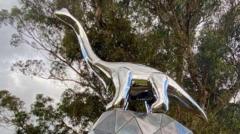Boom Boom, a seven-meter tall stainless steel dinosaur, has quickly become a talking point in the community since its recent installation.
Dinosaur Delight: New Zealand's Sculpture Sparks Controversy and Conversation

Dinosaur Delight: New Zealand's Sculpture Sparks Controversy and Conversation
A towering dinosaur sculpture in Taupō has stirred debate, drawing both praise and criticism from locals.
The installation of Boom Boom, a striking seven-meter tall stainless steel dinosaur sculpture, has rapidly ignited passionate discussions among the residents of Taupō, New Zealand. Created by Slovenian artist Gregor Kregar and commissioned by the Taupō Sculpture Trust, its reflective surface and impressive design have led some to label it an "eyesaur" while others celebrate its "fabulous" aesthetic.
Kregar expressed surprise at the debate, noting that art often prompts public interaction. "It's really hard to hate a sculpture of a dinosaur," he quipped in an interview from Auckland. Responses to the sculpture have ranged widely; several locals praised it for stimulating conversations about art, while others expressed frustration over its $100,000 price tag funded by local ratepayers.
While the controversy is palpable, Kregar maintains the rock upon which Boom Boom stands has a thematic link to the area’s volcanic history. Lake Taupō, after which the town is named, is itself a caldera resulting from a volcanic eruption about 1,800 years ago. The sauropods, an inspiration for the sculpture, are thought to have roamed the region millions of years ago before their extinction.
Kim Gillies, secretary of the Taupō Sculpture Trust, remarked that the choice to feature Boom Boom was deliberate, aiming to elevate the town's profile. She added, "When it comes to the art, safe is a bit boring, right?” Kregar believes the spirited exchange surrounding this sculpture could ultimately foster community affection, suggesting that as locals engage positively, Boom Boom might assimilate into the town's identity.
Thus, whether viewed as an audacious art statement or a misplaced investment, Boom Boom undeniably puts Taupō in the spotlight, highlighting the fundamental role of art in shaping communal sentiments.
Kregar expressed surprise at the debate, noting that art often prompts public interaction. "It's really hard to hate a sculpture of a dinosaur," he quipped in an interview from Auckland. Responses to the sculpture have ranged widely; several locals praised it for stimulating conversations about art, while others expressed frustration over its $100,000 price tag funded by local ratepayers.
While the controversy is palpable, Kregar maintains the rock upon which Boom Boom stands has a thematic link to the area’s volcanic history. Lake Taupō, after which the town is named, is itself a caldera resulting from a volcanic eruption about 1,800 years ago. The sauropods, an inspiration for the sculpture, are thought to have roamed the region millions of years ago before their extinction.
Kim Gillies, secretary of the Taupō Sculpture Trust, remarked that the choice to feature Boom Boom was deliberate, aiming to elevate the town's profile. She added, "When it comes to the art, safe is a bit boring, right?” Kregar believes the spirited exchange surrounding this sculpture could ultimately foster community affection, suggesting that as locals engage positively, Boom Boom might assimilate into the town's identity.
Thus, whether viewed as an audacious art statement or a misplaced investment, Boom Boom undeniably puts Taupō in the spotlight, highlighting the fundamental role of art in shaping communal sentiments.



















